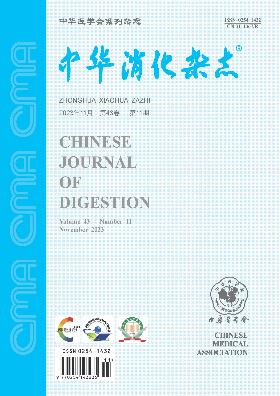Serum metabonomics study in 66 patients with gastric cancer by liquid chromatography-mass spectrometry
引用次数: 0
Abstract
Objective To detect whether patients with gastric cancer had unique serum metabolomic characteristics by liquid chromatography-mass spectrometry (LC-MS) metabolomic analysis, and to screen potential markers for early gastric cancer and to preliminarily explore the related metabolic pathways. Methods At the First Affiliated Hospital of Soochow University, 66 patients with gastric cancer and 44 patients with benign gastric disease from July, 2017 to January, 2018 were enrolled, and 50 healthy subjects served as controls. Twenty-five patients with gastric cancer at stage Ⅰ and Ⅱ and 25 patients with gastric cancer at stage Ⅲ and Ⅳ were selected from the 66 patients with gastric cancer, and 25 subjects were also selected from 50 healthy controls. The plasma small molecule metabolites of patients with gastric cancer and benign gastric disease and healthy controls were detected by LC-MS method. Multivariate logistic regression analysis was used to establish and validate the principal component analysis (PCA) model and partial least squares-discriminant analysis (PLS-DA) model and screen the differential metabolites. The receiver operating characteristic curve analysis was used to evaluated the clinical efficacy of differential metabolites. Results PCA and PLS-DA models showed that gastric cancer had a obviously specific metabolites profile, the profile of benign gastric disease overlapped with that of gastric cancer and healthy controls. The results of multivariate logistic regression analysis confirmed that four metabolites including isoleucine, benzophenone, sphingosine-1-phosphate and galactopyranose set could be used to establish an optimal diagnostic model. The area under the curve (AUC) (95% confidence interval (CI)) was 0.963 (0.930 to 0.997), and the best cut off value, sensitivity and specificity were 0.871, 93.1% and 94.0%, respectively. Meanwhile, patients with gastric cancer at stage Ⅰ+ Ⅱ and stage Ⅲ+ Ⅳ had a distinct clustering trend compared with the control group. In the serum of patients with gastric cancer at stage Ⅰ+ Ⅱ and stage Ⅲ+ Ⅳ, a total of 24 differential metabolites were identified, the concentration of five of which including lysine, carnitine, benzenesulfonamide, arginine and docosahexaenoic acid ethyl ester, increased along with the progression of gastric cancer. Pipecolic acid and kynurenine might served as biomarkers for early and mid gastric cancer (stage Ⅰ+ Ⅱ) screening. Conclusions LC-MS metabolomic effectively confirm the unique changes of serum metabolites in patients with gastric cancer. The screened differential metabolites have potential clinical application value for predicting the risk of gastric cancer. Key words: Stomach neoplasms; Metabolism; Biological markers; Liquid chromatography-mass spectrometer液相色谱-质谱联用法研究66例胃癌患者血清代谢组学
目的通过液相色谱-质谱(LC-MS)代谢组学分析,检测胃癌患者是否具有独特的血清代谢组学特征,筛选早期胃癌的潜在标志物,并初步探讨相关代谢途径。方法选取2017年7月至2018年1月苏州大学第一附属医院的66例胃癌患者和44例良性胃疾病患者,并以50名健康受试者为对照。从66例胃癌患者中选取25例Ⅰ、Ⅱ期胃癌患者和25例Ⅲ、Ⅳ期胃癌患者,从50例健康对照中选取25例受试者。采用LC-MS法检测胃癌、胃良性疾病患者及健康对照者血浆小分子代谢物。采用多元logistic回归分析建立并验证主成分分析(PCA)模型和偏最小二乘判别分析(PLS-DA)模型,筛选差异代谢物。采用受试者工作特征曲线分析评价差异代谢物的临床疗效。结果PCA和PLS-DA模型显示,胃癌具有明显的特异性代谢物谱,良性胃疾病的代谢物谱与胃癌和健康对照组的代谢物谱重叠。多因素logistic回归分析结果证实,异亮氨酸、二苯甲酮、鞘氨醇-1-磷酸和半乳糖ranose四种代谢物可用于建立最优诊断模型。曲线下面积(AUC)(95%可信区间(CI)为0.963(0.930 ~ 0.997),最佳截断值为0.871,灵敏度为93.1%,特异度为94.0%。同时,与对照组相比,Ⅰ+Ⅱ和Ⅲ+Ⅳ期胃癌患者有明显的聚类趋势。在Ⅰ+Ⅱ期和Ⅲ+Ⅳ期胃癌患者的血清中,共鉴定出24种差异代谢物,其中赖氨酸、肉碱、苯磺酰胺、精氨酸和二十二碳六烯酸乙酯等5种代谢物的浓度随着胃癌的进展而升高。细果酸和犬尿氨酸可能作为早期和中期胃癌(Ⅰ+Ⅱ期)筛查的生物标志物。结论LC-MS代谢组学有效地证实了胃癌患者血清代谢物的独特变化。筛选的差异代谢物在预测胃癌发生风险方面具有潜在的临床应用价值。关键词:胃肿瘤;新陈代谢;生物标志物;液相色谱-质谱仪
本文章由计算机程序翻译,如有差异,请以英文原文为准。
求助全文
约1分钟内获得全文
求助全文

 求助内容:
求助内容: 应助结果提醒方式:
应助结果提醒方式:


